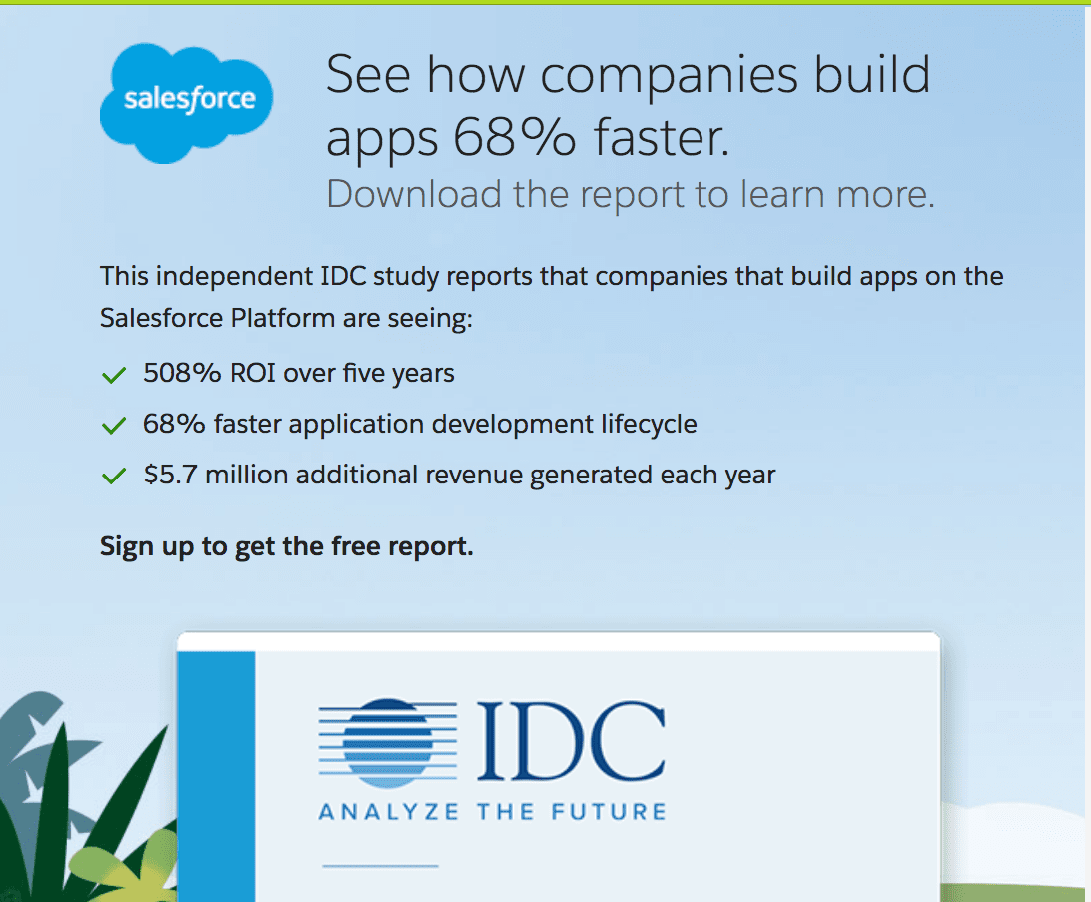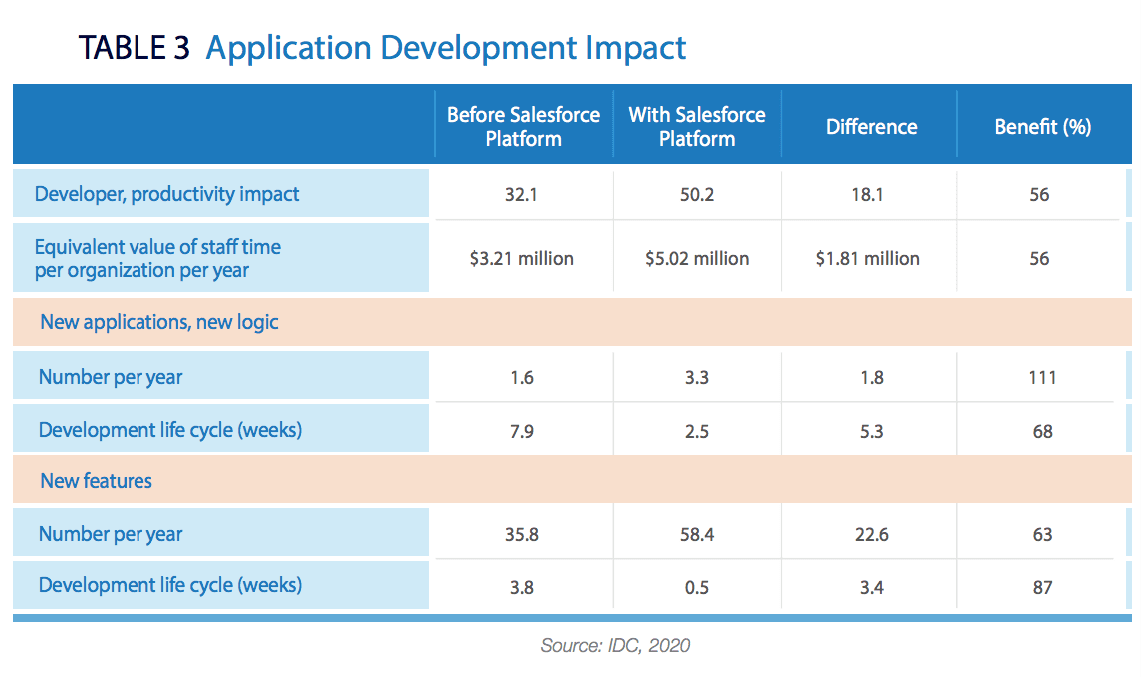Our Evaluation of the Information Quality Level on Salesforce ROI from Google Search Results
Executive Summary
- We review some of the highest-ranking sources on Salesforce ROI to answer the Salesforce ROI’s quality level.

Introduction
We review some of the most popular articles on Salesforce ROI to understand what is generally available to those searching on this topic. Our own site has several articles that rank high for a search on “Salesforce ROI,” however, we will leave our own articles out of this analysis.
See our references for this article and related articles at this link.
Article #1: Nucleus Research’s Salesforce Essentials Case Study Consulting
It is important to review this article first because CRM vendors are absolutely in love with Nucleus Research’s ROI studies.
By implementing Salesforce Essentials, 5P
Consulting tripled lead generation, saved each user approximately four hours per week from eliminated data entry and time spent searching for records, and avoided a business development hire. The software was implemented and ready to use within a week, and delivers an ROI of 998 percent to 5P Consulting. (emphasis added)
This is curious because Salesforce is an expensive application. It is also the highest ROI estimate I have ever read from any software implementation.
A 12 Hour Implementation?
The core functionality was implemented in approximately twelve hours. The CEO spent two hours customizing some aspects of the interface, implementing the email inbox integration with Salesforce, and adding other users to the system.
This is a lie. How was the data extracted and uploaded to Salesforce in 12 hours?
The system is easy to maintain and requires virtually no regular ongoing support. There are currently five users on the system.
Increased data transparency and visibility to sales pipeline. The shared dashboards and reports appear on the Salesforce homepage upon logging in, so all users have access to the same up-to-date data regarding sales pipeline and company health.
Increased data transparency and visibility to sales pipeline. The shared dashboards and reports appear on the Salesforce homepage upon logging in, so all users have access to the same up-to-date data regarding sales pipeline and company health.
This sounds suspiciously like vendor marketing material.
A Single Source of Truth?
Two of the most valuable aspects of the Salesforce instance to 5P are the dashboards and reports that are automatically displayed to all users from the home screen upon logging in. This ensures that the users always have a single source of truth that accurately displays sales and company performance metrics. This streamlines leadership meetings because all participants are accustomed to viewing the same data and can proactively address issues as they arise.
Notice how this last paragraph is written. This is exactly how vendor marketing writes and is not how a researcher writes.
The term “single source of truth” is a marketing construct, as we cover in the article How Valid is the Term Single Source of Truth? This term would be written in the report is another clue that Salesforce highly influenced this report. The first clue was the exorbitant ROI, and the second was the ridiculous implementation time.
Nucleus Research has done some interesting work in the past, but vendors make it so that it is challenging to stay in business without eventually selling out to them.
We have seen all of the IT analysts sell out.
And Nucleus Research has done this in a big way with not only Salesforce but to the overall CRM software category.
Article #2: Nuvem Consulting’s The ROI of Salesforce
This article is deceptive and of such low quality that there is nothing I will write about it, except to give it a score of a 1 out of 10.
Article #3: Salesforce Training’s Why Your Not Maximizing Your Salesforce ROI
Have you ever stopped to think – well, we’ve invested in this glorious tool – and trust me, glorious it absolutely is – but for some reason we’re just not getting the results that we were hoping for.
Salesforce is “glorious?” This company must be using a different Salesforce than I have tested.
As mentioned, one of the key reasons for not realizing your potential Salesforce ROI is based on the technology of Salesforce itself, specifically, how it has been configured. Or, in your case quite possibly, not configured. And it happens far too often. We’ve actually worked with many companies that have spent six and even seven figures on a Salesforce implementation. And some aspects of the system may be designed to work extremely well. But sadly, for the sales team, their requirements were given the short shrift.
We’ve seen flaws from not having the actual sales process – if one has been defined at all – be properly represented in the Opportunity Stages, one Opportunity Record Type for multiple types of Opportunities, not using some of the native tools like Sales Path, not tracking the right activities, or making tracking too cumbersome, and far too little attention given to the mobile experience – probably the most important element. We’ve seen systems so over-engineered that the salesperson needs to jump through so many hurdles just to log a call or close a deal, we don’t blame them for not wanting to use it. We wouldn’t either quite frankly.
This quote brings up a question. How was Salesforce implemented in 12 hours in the case study presented by Nucleus Research?
The rest of the article brings up some reasonable questions about how to get an ROI from Salesforce.
Article #4: Productiv’s How to Measure Salesforce ROI
Productiv normally has decent articles on ROI because they are not trying to sell a CRM system or consulting, but selling a SaaS application that measures the usage of other SaaS applications.
Productiv’s leading SaaS Management Platform enables you to easily see Salesforce usage trendlines, get notifications on weekly or monthly changes, and set adoption goals to drive up the value your organization is getting and drive down the dollars your IT budget is wasting.
Being able to drill down where you need is critical. Dynamic filters enable you to pinpoint gaps where you may not be getting maximum value out of Salesforce, and identify specific areas where Salesforce cost control measures can be taken.
This is all good information. This is not an endorsement of Productiv’s software, as I have never tested it, but they have good points to measure their application usage.
Article #5: Salesforce’s The Basics of Marketing ROI
This is more marketing piffle, but this time from Salesforce. It is not about Salesforce ROI, but about the ROI from marketing, which means using Salesforce. It contains passages like this.
Accurately measuring marketing ROI is key to improving your marketing strategies, no matter your industry or whether you’re an SMB or enterprise business. When you use marketing technology to power your MROI analysis, you’ll have the data you need to create messaging that connects with customers on all their preferred channels.
I have read many articles from Salesforce, and they are similar to this article.
Article #6: Dazeworks’ Measuring Salesforce ROI
Now that you have a Salesforce solution in place, your key decisions will be based on precise, quantifiable, and accurate data. Let’s be honest, implementing Salesforce is a costly investment, but the ROI is equally humongous.
This quote is false.
There is nothing in Salesforce that guarantees data will be precise and accurate. Tons of Salesforce customers complain about the lack of accuracy of the data in their Salesforce system.
Salesforce is a costly investment — however, there really is no reason CRM systems should be expensive. This should have anyone call into question why they are paying for any premium price CRM application.
It is a given that most ROI reporting will be inclined to hardcore numbers like the increase in conversion rates, reduction in sales cycle, a growth in average deal sizes and so on. But it might also be a grave mistake to overlook how happy and comfortable your CRM users are with the brand new technology you have equipped them with. Your Salesforce ROI reporting will be incomplete if you fail to measure how your CRM users, most importantly your sales reps, feel.
Application satisfaction is a major factor in how much and how effectively users leverage the application. So this is true.
Article #7: Simplus’ ROI Salesforce Digital Transformation
A 2016 study by the firm IDC found that Salesforce customers, on average, begin experiencing payback from their investments in Salesforce products in 13 months or less, and, by the end of the first four years, financial benefits outweigh costs by three to five times.
This is another exaggerated estimate from another unreliable source. I will get into this study a little further down in this article.
This article by Simplus is filled with rosy and unsubstantiated claims, like the one below.
Furthermore, customers begin to have overwhelmingly positive interactions with your company as they get the information, offers, and updates they want in an efficient, frictionless manner. You should be monitoring how both employee and customer satisfaction levels change following Quote-to-Cash implementation; employees and customers alike are likely to be happier and more loyal with Quote-to-Cash.
There is no concern for what is true in this article, and so it receives a score of 1 out of 10.
Article #8: Panaya’s Optimize Lightning ROI
This article is a marketing piffle about some product named Salesforce Lightning. There is nothing to say about it, except it deserves a 1 out of 10.
Article #9: IDC’s Salesforce Economy Study 2016
This is the study I stated I would get into further on in the article. This is the quote in the study to which the Simplus article is referring.
In an IDC survey of 1,142 cloud-using organizations in eight countries conducted in 2015, Salesforce customers said, on average, they have experienced payback from their Salesforce technology investments in 13 months or less. Over four years, aggregate worldwide investments by Salesforce customers in cloud computing should yield three to five times the financial benefits compared with costs.
However, there is no link to this study in the IDC article.
Furthermore, Salesforce has paid IDC for several studies, and these vendor-sponsored studies invariably end up being controlled by the vendor. They rely on the vendor to provide the data points, which of course, allows the vendor to cherry-pick the data points or case studies, as we covered in the article How to Understand Forrester’s Fake S/4HANA TCO Study.
 Observe how the term “independent” is used. However, if Salesforce sponsored the study, how is it independent? IDC is a separate company, but as Salesforce pays it, it is not independent.
Observe how the term “independent” is used. However, if Salesforce sponsored the study, how is it independent? IDC is a separate company, but as Salesforce pays it, it is not independent.
If both IDC and Salesforce will lie about the study’s independence, why would they also not lie about the study?
Secondly, IDC is owned by a Chinese company.
- There are no research standards in China.
- There is no freedom of speech in China.
I understand that IDC itself is not based in China, but Chinese controlled entities are not credible concerning media, publishing, or research. Furthermore, Salesforce is constantly lying on their website, so it isn’t easy to believe anything they say or sponsor.

IDC is a constant source of information for how fantastic everything Salesforce is. This is a screenshot from a different study titled The Business Value of Salesforce Platform for Application Development. Notice the benefit from using the Salesforce application platform is very large.
As with the previous IDC study, this study is filled with paragraphs written in the vendor speak.
Salesforce marketplace delivers a collection of capabilities that is easy to assemble into a solution and has an opportunity to better articulate the collaborative value of the Salesforce Platform and reuse of components to developers. As organizations face challenges in finding new sources of revenue, the Salesforce marketplace combined with integration and analytics capabilities can be the avenue to build and sell solutions.
If any IT analyst wants to keep getting income from Salesforce, they know they need to provide reports that show major benefits from using Salesforce. That is, they know they need to create good “marketing collateral” for them.
Vendors love dictating more and more to customers.
This Salesforce Application Development Platform is yet another example of this. And the more the customer uses the products from one vendor, the more that vendor blocks out other vendors and other alternatives. This is how mega-vendors, in particular, take over accounts. The vendor wants to cut off your choice, so you cannot negotiate with them.
The Logic for Stopping at This Point
There was really nothing new coming from any of these articles. And as we looked at more of the articles down the list in the search results. It didn’t seem as if there would be anything else coming down the pike if we continued to read more articles. So at this point, we decided that this would be where we would stop.
So now, let us get into the scores.
The Table of Our Scores
The following is a tabular form of the articles we just covered.
Salesforce ROI Articles Found On Line
| Website | Article Description | Article Link | Our Rating 1 to 10 |
|---|---|---|---|
| Nucleus Research | Salesforce Essentials Case Study Consulting.PDF | Link | 1 |
| Nuvem Consulting | The ROI of Salesforce | Link | 1 |
| Salesforce Training | Why Your Not Maximizing Your Salesforce ROI | Link | 4 |
| Productiv | How to Measure Salesforce ROI | Link | 7 |
| Dazeworks | Measuring Salesforce ROI | Link | 3.5 |
| Simplus | ROI Salesforce Digital Transformation | Link | 1 |
| Panaya | Optimize Lightning ROI | Link | 1 |
| Salesforce | Marketing ROI Basics | Link | 1 |
| IDC | IDC Salesforce Economy Study 2016 | Link | 1 |
Conclusion
All of the articles reviewed above are quite repetitive.
- There were many false claims made in most of the articles. Many of the articles were not worth reading.
- The articles were highly biased as most were written by those selling Salesforce software or consulting.
- Almost all the articles were written so that the author could put out a minimal level of effort.
- Few of the articles addressed the reality of the difficulty of an accurate Salesforce ROI calculation.
- Nearly all the articles appeared to presume that any ROI estimation of a Salesforce system would be positive and relied on industry-funded studies by companies not following research rules. However, none of the sources referenced are reliable.
The average score of the 9 articles reviewed was 2.27—the highest-scoring article coming from Productiv, which we scored a 7.
What Did We Expect?
We did not have great expectations of what we would find before performing this analysis. However, the results are far worse than we would have guessed.
It is difficult to say that any of these articles is worth the time to read. The only way it would be is if you were entirely new to Salesforce ROI.